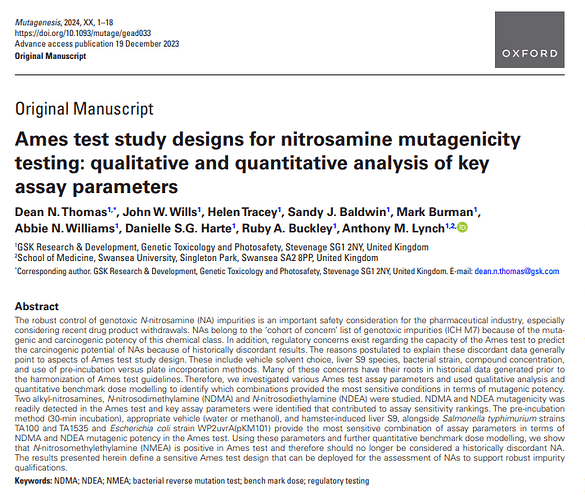Paper published today on AMES test study design for nitrosamines, including showing NMEA as Ames positive.
A fantastic paper! A must read…
Conclusions:
The current study confirms the mutagenicity of alkylnitrosamines can be readily detected in the bacterial reverse mutation test (Ames test). Using advanced data analytics and modelling we show the assay parameters most sensitive for this class of compound including the pre-incubation method (with a 30-min incubation period) compared with plate-incorporation. Either water or methanol was suitable as vehicles, and hamster-induced liver S9 was the superior exogenous metabolic system, although rat liver S9 also elicited a positive response, albeit with less potency.
Since there are examples of nitrosamines which are Ames test positive with rat liver S9 and negative with hamster liver S9 [27], we recommend both systems be used in parallel at the present time. S. typhimurium TA1535 and TA100 and E. coli WP2uvrA (pKM101), were the most sensitive bacterial strains, and these strains should be included as part of the 5-strain Ames test when evaluating the mutagenicity of nitrosamines
Dear Naiffer,
Most of times US FDA is not accepting the output of the AMES test result. For e.g As per EMA N-Nitros Dabigatran AI limits has been revised i.e (1500ng/day) mentioned Limit based on negative bacterial reverse mutation test.
The USFDA Agency does not accept the EMA guidance. FDA recommend that for tightening the proposed limit for N-nitroso-dabigatran be consistent with FDA AI approved limit (I.e 400ng/day) or or asks for toxicology data to justify proposed limits.
Could you Or anyone from forum please suggest any study report of toxicology data of N-Nitrso dabigatran?
Its surprising to know!
If you have time, you may need to conduct own experiments (in vitro or in vivo) and add on provide QSAR justification- There could be a chance of acceptance!
Although it looks little weird generating again experimental data even though we know N-nitroso Dabigatran is negative in EAT. That’s the fact, unfortunately US FDA and EMA are not aligned in all aspects.
What’s your experience, only in vitro or in vivo, is extra in silico mechanistic data to verify hypotheses and explain EAT data accepted as well?
With extra in vitro is your experience only the type of additional in vitro experiments FDA conducts in house as well for mutagenicity risk assessment on nitrosamines (mammalian gene mutation assay, micronucleus test, identification of predominant CYP enzyme bioactivator if any) or would case-specific designed metabolisation studies in vitro be accepted as well?
Is the extra data to support Ames still comparable to what was discussed during FDA/HESI Research Roadmap Planning on Hazard and Risk Assessment of Nitrosamine Impurities in Drugs”, 31 May-1 June 2023 (already then underlining metabolisation-designed Ames testing and holistic WoE approaches) or are things evolving further?
How do you link in vivo with QSAR justification?
You mean BMDL calculation and potency ranking from positive in vivo mutagenicity study data?
Or just using in vivo data to substantiate the appropriateness of readacross with an analogue with known TD50 data (or negative in vivo mutagenicity data?) to replace the CPCA AI?
Are there examples of FDA valorisation of new in vivo data public or presented at recent conferences?
Mr. Pradeep, Thank you.
In vitro and in vivo is another level that takes time. we can try to make some change in formulations to reduce the risk. I don’t think a QSAR report will be accepted from an USFDA who doesn’t accept AMES test.
Thats why in the meantime time i am looking for any study report which is present any toxicity data which is suitable for wider range.
For extra data on the case of N-nitroso-dabigatran: see SOT 2024 poster presented by FDA scientists:
This is the big update that I am awaiting from the FDA.
I check daily to see if I can find anything published by the FDA or authors on this work, but to date there has been nothing.
There are several molecules in this that have been shown to be negative by the FDA’s own AMES testing, and by their new methodology, but the limits have not been updated in the official guidance so far.
@DR. Clarence Wybon
This poster can help point the way.
Thanks @ccdw - I think the FDA posters shared already answers. I am surprised why FDA still not revised AI of N-nitroso Dabigatran.
I have been working on N-nitroso Dabigatran since 2022, Way back in 2023 only with expert QSAR and EAT we have proposed AI should be more than 18 ng/day or 400 ng/day at that point of time with Europe. I am confident this is not of potential concern. I hope now the data generated from FDA itself should be convincing that N-nitroso Dabigatran AI should be revised.
I have small doubt- How does the comet assay reacts with N-nitroso Dabigatran? Although in vitro mammalian mutation assay and Micronucleus test came negative- Because as a genetic toxicologist, I have slight doubts on these negative results.
But overall, I am convinced that N-nitroso Dabigatran is really not of major concern!
N-Nitroso Isavuconazonium sulfate limit asper CPCA calculation, with potency category 2 and AI:100 ng/day?
what is N-Nitroso Isavuconazonium sulfate limit now?
